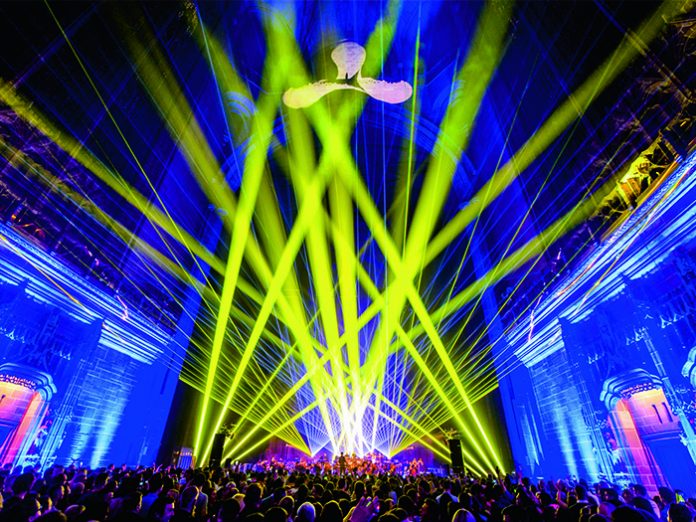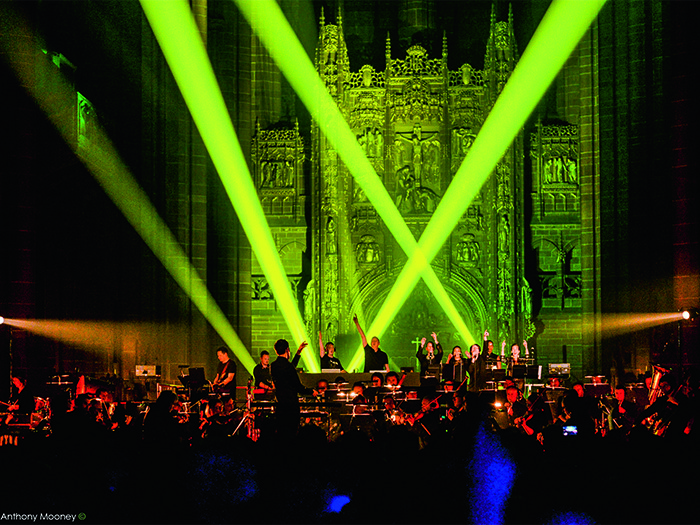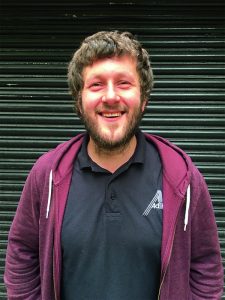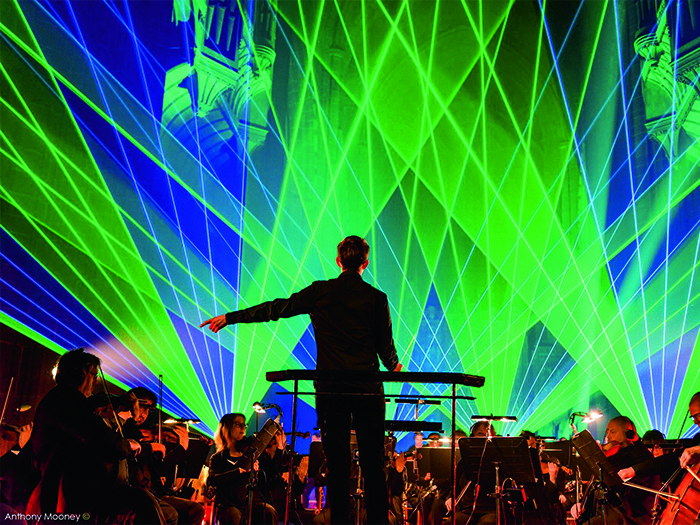
When Cream announced a night of dance music classics as you’d never heard them before, performed by the Royal Liverpool Philharmonic Orchestra in one of Liverpool’s most iconic and breathtaking buildings, Liverpool Cathedral, needless to say the city was brimming with excitement. TPi spoke to the suppliers who brought the event together.
Uniting three of Liverpool’s cultural institutions for a unique event saw global dance brand Cream collaborate with musicians from the Royal Liverpool Philharmonic Orchestra, and transform some of the greatest dance classics from the electronic music genre in the majestic surroundings of Liverpool Cathedral.
The unique concert featured special guest vocalists and performances. Curated by dance music duo and former Cream residents K-Klass who carefully selected the soundtrack for the concert, key contributors included Executive Producer Dave Green from Liverpool’s Ameritz Music and Conductor Tim Crooks, whose wealth of experience spans different sectors of the music industry.
Sandra Parr, Liverpool Philharmonic’s Artistic Planning Director, said: “We’ve worked with many of Liverpool’s great artists from across every style of music, though this will be the first time we’ve worked with Liverpool’s iconic, international club brahirnd and it’s a collaboration that we’re really looking forward to. The magnificent setting of Liverpool Cathedral, the fantastic sound of the Royal Liverpool Philharmonic Orchestra along with the essential Cream club mix is set to be a memorable night of great music in the city.”
As the UK’s biggest cathedral, and famously called, “one of the great buildings of the world” by poet Sir John Betjeman, this 20th Century architectural masterpiece dominates Liverpool’s skyline. Resonating with all its heritage, history, ambition and creative possibilities, a centre of worship, learning, culture and tourism, made the venue a perfect backdrop for the unique event.
A Creative And Challenging Production
Andy Owen, Head of Creative at Cream, told TPi: “We’d seen several shows where DJs had worked with orchestras – it’s not a new idea as names such as Paul van Dyk, Paul Oakenfold and Jeff Mills have all worked with orchestras previously, and of course Pete Tong’s incredible BBC Radio 1 Ibiza Prom garnered a reaction from the audience and the wider public that was quite something. We felt there was a real appetite for more of these kinds of shows but we wanted to do it our way – to make it fit for Cream and Liverpool. Cream’s classic tracks re-imagined with an orchestral and impressive production but in a venue to match – that’s where Liverpool Cathedral came in. We worked with Sam Newson of The Events Company UK on a lot of our tours and events – he’s great at taking a few outline ideas and concepts and turning that into a working show.”

The Events Company UK supplied Production Management duties while Adlib provided both sound and lighting requirements. AC Lasers brought laser expertise into the mix, West Coast Hire & Events provided staging elements and additional local crew came from DNG.
Owen continued, speaking of the idyllic venue choice for this prestigious, two night production: “Liverpool Cathedral is the largest cathedral in the UK and the fifth largest in the world… what better for a backdrop for Cream Classics? The venue had to be part of the show – that was my main focus for the production, to light the cathedral rather than light a show within it. Plus, as a cultural organisation, the cathedral is incredibly forward thinking; artist Tracey Emin’s 20ft pink neon message Love to Liverpool hangs over the main entrance of the building.
“Our entire production team, crew and suppliers delivered an incredibly clear sound, impressive lighting show and what has to be one of the best laser shows in one of the most challenging spaces we’ve ever worked in.”
The Events Company UK Director Sam Newson agreed: “I had a very specific idea as to what I wanted to achieve from the look of the show and Adlib were great in working with us on the design aspects. I knew that the main focus of our design should fit around lighting of the interior of the cathedral and the building itself so I wanted to make the altar a real feature like a backdrop to the stage. Part of the design was also governed by how the Royal Liverpool Philharmonic Orchestra wanted to be lit; with white light directly from above. This meant no front, back or side lighting, no strobes and no moving lights anywhere near them. This naturally impacted the look of the show. Putting in ground supports weren’t really an option as this would take away from the building – so everything had to be done from the floor up or at head height. I worked closely with Adlib’s Dave Eldridge and Kevin Byatt throughout the whole process to ensure that we were able to achieve the look we wanted.”
For The Events Company UK – whose team included James Dutton and Mick Pearce – the venue brought its fair share of challenges. Continued Newson: “Between 8am-6pm the cathedral is open to the general public so all walkways had to be clear, and kit put away, apart from the main stage. We also had to down tools and stop working for several hours a day whilst prayers and services were taking place. The whole cathedral has a marble floor so everything had to have extra protection, from carpeting the bottom of speakers to covering the bottom of every single stage deck. Combined with the previous challenges mentioned and the acoustic issues of trying to mix dance music with a 60-piece orchestra, guest vocalists and session musicians in a cathedral, it meant it certainly was one of the most technically challenging shows we’ve ever done. However, watching several thousand people being blown away by a show that we’ve been working on for six months was definitely the most rewarding part of the job.”
Audio
The acoustically challenging sound design was handled with ease by Adlib. The main PA consisted of ground stacked Coda AiRAY boxes – four on top of one SC2 and three SCP per side. Adlib’s Richy Nicholson, who mixed FOH for the gig commented: “Due to the cavernous size of the building hosting two sold out nights, we put in delay stacks consisting of four SCVs and six ViRay boxes per side just behind FOH. Coda’s G Series boxes were used for front fill and also as extra delay boxes to fill in some holes at the rear of the cathedral.”

The speaker system was powered by Coda’s LINUS amplifier platform. At FOH, a DiGiCo SD7 console was used for mixing. Continued Nicholson: “There were a lot of inputs coming from the stage; the Royal Liverpool Philharmonic Orchestra alongside Cream’s own musicians and six vocalists meant all the extra faders I needed were available on the SD7, so it was a good choice.”
At the monitor position, a DiGiCo SD10 (mixed by Chris Smethurst) alongside 12 of Adlib’s MP4 wedges which were used for the Cream musicians, and a custom headphone monitoring system – designed by Adlib – serviced the orchestra’s needs. Nicholson said: “The microphone package comprised DPA 4099’s which were used to close mic all of the strings, and then a mixture of Shure and Sennheiser dynamic mics and Shure and AKG large diaphragm condensers were in play for the brass, woodwind and percussion players. Shure’s UHF-R systems were used for the vocalists – SM58 capsules on UR2 handheld units. A mixture of Sennheiser mics and Radial DIs were used for the rest of the musicians.”
Continued Nicholson: “We chose DiGiCo for a few reasons really. Partly because of the massive channel count and partly because they’re consoles that both Chris and myself are very familiar with. There’s a lot of clever things that it can do that make managing a big channel count easy such as multi channels which allow you to get up to 12 channels ‘folded’ together onto one fader. This then allows you to get a lot of inputs onto one layer of the console so you’re not bouncing around different banks trying to find the instrument that is taking the lead. You then have the option to link together the parameters of each of those 12 channels, so you can EQ them all as one.
“The brief was to make this gig feel like you were in a club listening to these classic songs with the added element of all these fantastic musicians carrying all the melodies. The Coda AiRAY system worked really well, mainly due to the control it has, along with the work of Billy Bryson, our System Tech, who made it work in this venue.
“A combination of good mic placement, and good deployment of the system meant that we could create that club feel and still have the orchestra keep up volume-wise. It also gets pretty chaotic when you’ve got so much going on in such an ambient space but by putting a delay system left and right half way down the room, we were able to get the energy from each speaker stack up above people and directed down into the audience space rather than having the main PA pointing all the way to the back of the room to cover everywhere. It still sounded like you were listening to a gig in a cathedral, but we were able to get enough definition and body into the room so that everybody left the gig feeling happy.” Terry Smith and Laurie Binns also worked on the Adlib Audio team.
James Dutton of The Events Company UK explained that the playback for the show was run on Logic Pro X via two Macbook Pro Retinas as an A and B system. The playback rack consisted of two Focusrite Scarlett 18i 20 and a Radial SW8 MK2 Auto Switcher which linked the two systems together, with the possibility to switch seamlessly to the back up system with a push of a button if there was a failure.
Dutton told TPi: “The two laptops were synced via Midi split so both laptops could be triggered in sync. I tried a few different systems to keep the laptops synchronised including MTC and LTC generators but its a case of the simpler the system the more reliable it is and less to go wrong. The playback project was sending drums, bass, some of the backing vocals and effects as well as the metronome as separate outputs to FOH and monitors. This of course, gave more control over the mix at FOH.”
Lighting
The lighting rig comprised mainly Martin by Harman fixtures. The moving light package specified 20 MAC Viper Washes, 16 MAC Auras, two MAC Viper Profiles. Also present were 20 Clay Paky Mythos. LED lighting was made up of 36 Core ColourPoint CP20 RX LED battery uplighter and the generic lighting units were four Arri 2000W fresnels, eight Arri 1000W fresnels and 12 ETC Source Four Profiles.

The MAC Viper Washes were used to colour the altar as a backdrop behind the stage, and also to highlight the architecture. The Martin by Harman MAC Auras were used onstage to give some footlights and dynamic effects to the orchestra and the Clay Paky Mythos were placed behind the stage and on the pre rig truss left and right of the stage in order to give a wide spread of beam effects across the whole orchestra and the audience. The LED uplighters were set up across the length of the cathedral to create ambience and to effortlessly highlight the cathedral’s stunning architecture. Finally, the two Martin by Harman MAC Viper Profiles helped to project Cream logos into the roof space of the building. The rig was controlled via an MA Lighting grandMA2 Light console, and operated by Adlib Lighting Designer, Kevin Byatt. The lighting crew from Adlib was completed by Charlie Rushton, Stuart Gray, Ste Dolling and Rob Bickerstaffe.
Laser
The atmospheric visual elements were also catered for by Daniel Briggs and Andy Thompson of AC Lasers which supplied a mix of RTI Nano AT6’s and RTI Piko 14’s for laser projection, and several AC Lasers BeamNET-PROs for the beam effects. Thompson said: “Using OPS lasers in a venue such as this is really important because the high beam quality these systems offer give the most sharp and vivid display for the audience, regardless of where you’re watching from.”
Briggs operated the laser show on both nights. He said: “I was excited to be part of such a unique production, and tailoring the cue programming to the upbeat tempo of dance music classics, with the rich sound of the orchestra in such a stunning venue, was an enjoyable challenge.”
He added: “The addition of 90 parallel red laser beams from the BeamNET-PROs came into their own on Mark Knight’s Man with the Red Face, as they created a sharp ceiling of light throughout the length of the cathedral.”
In conclusion of this culturally important technical feat, Adlib’s Dave Jones commented: “It was great to be part of such a new and challenging concept. We work often with the Royal Liverpool Philharmonic Orchestra and it was really interesting to see both their world and the dance world come together for such a unique event. I was really impressed with the whole show; credit goes to Sam and the whole production team for pulling it all together. It’s something that we are proud to be associated with.”
TPi
Photos: Anthony Mooney
www.tec-uk.co.uk
www.adlib.co.uk
http://aclasers.co.uk
https://dngproductioneventcrew.wordpress.com
http://hireandevents.co.uk





